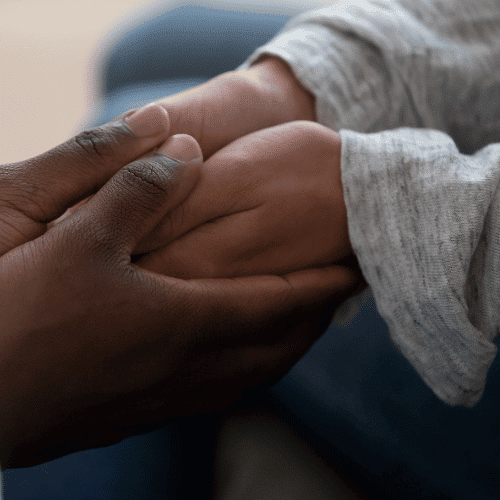Suicide is a leading cause of death in the United States. 620 Marylanders died by suicide, according to the latest data (2021) available from the Centers for Disease Control.
More people die by suicide each year than by homicide.
If you or someone you know is at risk, call 988 to talk with a trained professional.
Who Is At Risk?
Suicide does not discriminate. People of all genders, ages, and ethnicities are at risk for suicide. But people most at risk tend to share certain characteristics. The main risk factors for suicide are:
- Depression, other mental disorders, or substance abuse disorder.
- A prior suicide attempt.
- Family history of a mental disorder or substance abuse.
- Family history of suicide.
- Family violence, including physical or sexual abuse.
- Having guns or other firearms in the home.
- Incarceration, being in prison or jail.
- Being exposed to others’ suicidal behavior, such as that of family members, peers, or media figures.
The risk for suicidal behavior also is associated with changes in brain chemicals called neurotransmitters, including serotonin, which is also associated with depression. Lower levels of serotonin have been found in the brains of people with a history of suicide attempts.
Many people have some of these risk factors but do not attempt suicide.
Men And Mental Health
Men often struggle with talking about mental health, but they’re more likely to die by suicide than women.
Women are more likely to attempt suicide.
If you're a man, get empowered to talk about your mental health by listening to the 92Q webinar on men's mental health issues. Hear from other men who have struggled with their mental health and what they've done to get help.
Teens And Adolescents
Children and young people are at risk for suicide. It’s the second-leading cause of death in young people between the ages of 10 and 24, according to the Centers for Disease Control.
During adolescence, a lot is happening socially, emotionally, and mentally. These changes, a family history, personal history, institutionalized racism, family violence, sexual orientation confusion, bullying, abuse and food instability can also increase an individual’s risk.
LGBTQ+ youth are three times more likely to report having suicidal thoughts and five times more likely to attempt it.
Talk to your teens about their mental health, and look for warning signs of a behavioral health concern.
Youth may find support in a general behavioral health or suicide prevention program or through a teen-focused program like MDYoungMinds or Taking Flight.
MDYoungMinds is a text support program through 211 and the Maryland Department of Health, Office of Suicide Prevention. It sends supportive text messages focused on teen and adolescent mental health concerns and stressors.
Taking Flight is a peer support program with young adult leaders (aged 18 to 26) who have personal experience with behavioral health concerns or trauma. They empower young adults with weekly virtual meetups and social media peer support.
Older Adults
Older adults are at risk for suicide, too. In fact, white males age 85 and older consistently have the highest suicide rate than any other age and ethnic group.
Recognizing Suicide Warning Signs
There are often warning signs that someone is thinking about suicide. They may become isolated or remove themselves from conversations or activities they once enjoyed.
Mental Illness
Knowing the signs of depression or mental illness are important in preventing suicide.
Signs of mental illness may begin to appear when an individual is a teenager. In the “What’s the 211?” podcast, NAMI Maryland said signs are typically observed around age 25 to 30, at the latest. But, it can impact someone at any time in their life.
Kate Farinholt, Executive Director of the National Alliance on Mental Illness in Maryland (NAMI Maryland), said,
“The difference between having a mental health issue and having a mental illness, it’s a sort of a sliding scale. So people can contact us often because they are anxious, depressed, stressed and want to get information about how to deal with that.
And it might be temporary, but getting a diagnosis of a mental illness is complicated and there’s no easy test to let someone know if they actually have a mental illness and where it might also be a reaction to some kind of physical disorder. Each mental illness has its own symptoms.”
Common warning signs include:
- excessive worrying or fear
- feeling excessively sad
- having confused thinking or problem concentrating
- extreme mood changes can make a difference
- self-isolation
- pulling away from things that used to give you joy
- ability to carry out daily activities
- inability to handle daily problems or stress
A chemical imbalance or situation often causes mental illness. A divorce, stress, loss of a loved one, family situation, environment, or a chronic medical condition can all contribute to a mental illness. There may be a number of causes of this illness.
Finding Support
Finding the support is critical so treatment is not delayed.
Kate Farinholt of NAMI Maryland explained, “And, the average delay between diagnosis and treatment for mental illness is 11 years. That means people who are affected are not getting the necessary supports when they need them the most. And that’s partly because of stigma and self-stigma, but it’s also because there’s a lack of in-network community behavioral health providers. There’s a routine denial of insurance coverage.”
You can find mental health support in Maryland by:
- Calling 988
- searching the state's behavioral health resource database, powered by 211
- Connecting with a 211 mental health program
You are not alone. Help is available.
Suicide Prevention In Maryland
One of the ways to prevent suicide is to connect individuals who are struggling with free and low-cost mental health support.
211 Maryland is committed to preventing suicide with innovative programs like 211 Health Check. It’s a weekly check-in with a caring and compassionate professional. The suicide prevention program (Thomas Bloom Raskin Act) is in honor of Tommy Raskin, who died by suicide. He is the son of Congressman Jamie Raskin.
With this program, there’s someone available to listen to your struggles and connect you with the support you need each week.
Maryland Suicide Prevention Helpline
If you know someone who is considering suicide, do not leave him or her alone. Try to get your loved one to seek immediate help by calling 988. You can also chat online with a mental health professional in English or Spanish.
Professionally trained specialists are available 24/7/365 to listen and talk.
211 specialists with Baltimore Crisis Response answer some of these calls. Elijah McBride is the Call Center Manager and spoke about the ways they can help individuals on the “What’s the 211?” podcast.
“So, when someone calls in, they’re going to be connected directly with a trained hotline counselor. That hotline counselor will provide adequate and accurate information to them, listen to them, and really brainstorm potential options and solutions to the particular crisis or problem they present over the phone,” McBride explained.
Other Ways To Prevent Suicide
Effective suicide prevention is based on sound research. Programs that work consider people’s risk factors and promote interventions appropriate to specific groups of people. For example, research has shown that mental and substance abuse disorders are risk factors for suicide. Therefore, many programs focus on treating these disorders and addressing suicide risk specifically.
Psychotherapy, or “talk therapy,” can effectively reduce suicide risk. One type is called cognitive behavioral therapy (CBT). CBT can help people learn new ways of dealing with stressful experiences by training them to consider alternative actions when thoughts of suicide arise.
Another type of psychotherapy, called dialectical behavior therapy (DBT) has been shown to reduce the rate of suicide among people with borderline personality disorder, a serious mental illness characterized by unstable moods, relationships, self-image, and behavior. A therapist trained in DBT helps a person recognize when his or her feelings or actions are disruptive or unhealthy and teaches the skills needed to deal better with upsetting situations.
Some medications may also help. For example, the antipsychotic medication clozapine is approved by the U.S. Food and Drug Administration for suicide prevention in people with schizophrenia. Other promising medications and psychosocial treatments for suicidal people are being tested.
Still other research has found that many older adults and women who die by suicide saw their primary care providers in the year before death. Training doctors to recognize signs that a person may be considering suicide may help prevent even more suicides.
You can find behavioral health support groups and counseling by searching mental health support resources in a database powered by 211. You can also call 2-1-1 to speak with a specialist who can connect you with free and low-cost resources in your community.
Talking About Suicide
You can help prevent suicide with candid conversations. They show support to the individual help break down mental health stigmas and barriers.
Mental health knows no boundaries and can impact anyone.
On “What’s the 211?” podcast, Brandon Johnson, MSH, host of The Black Mental Wellness Lounge on YouTube, talked about the reluctance to talk about suicide. “Like suicide is such a heavy topic. I totally understand that, but as we see our rates in specific communities continuing to rise, it’s important that we understand that suicidal ideation is real.”
When talking about suicide, choose words carefully.
“I tell people all the time to shift language from committed suicide to dying by suicide, to someone who we don’t want to stigmatize and criminalize someone who felt so hopeless that they felt the need to make an attempt on their life. And, so we want to change the language. So, people feel that they can have the conversations in a safe space and not be harmed, initially just by the language before they even have it as a chance to experience the potential for hope and recovery,” Johnson explained.
Also, avoid generalized characterizations of people or slang.
Johnson explained, “So, we may say this person’s OCD or this person’s acting bipolar, or this person is schizophrenic, without actually taking into consideration what that really means and how stigmatizing that is to a person who may be bipolar, right? Who may be schizophrenic, who may have OCD. In trivializing, their experiences to a slang term use, usually interrogatory to someone else is, is something that can be damaging even down to suicidal ideation.”

Talking To A Friend About Their Mental Health
If you notice someone who seems down, sad, lonely or uninterested in normal activities or get-togethers, reach out to them and ask them how they’re doing.
It may be an uncomfortable conversation, but it’s essential to prevent suicide. It’s preventable, and it starts with conversations. The National Alliance on Mental Illness (NAMI) suggests creating a safe space for the person to talk, ask open-ended questions, and start the conversation with “I’ve noticed….”
It’s ok to talk about suicide and mental health. Be ready to listen!
The Maryland Department of Health and the Maryland Office of Suicide Prevention recommend phrases like these:
- We haven’t talked in awhile. How are you?
- You seem down lately. What’s going on?
- I’m worried about you. Is something wrong? I want to be there for you.
- You haven’t been yourself lately. Are you ok?
- Is there anything you want to talk about?
It’s essential to listen and show that you care. Support your family member or friend by getting together with them or checking in on them.
You’re not expected to provide advice, but you can refer them to free and confidential resources like 988, 211 Health Check, MDYoungMinds or MDMindHealth/MDSaludMental.
Also, consult other resources for ideas in talking about mental health and suicide, like discussions from mental health experts like Johnson. He has a series of discussions with school counselors, a child psychiatrist, and other experts covering topics like supporting a family member with their mental health, using mindfulness meditation to support your mental wellness, racial trauma and transforming your pain into passion.
Talking To Your Children About Suicide And Mental Health
In several, What’s the 211? podcasts, guests have discussed the reluctance many people have in talking about suicide.
Amy Ocasio of the LIVEFORTHOMAS Foundation, talked about the struggle of talking to her children about their struggles.
“So, I definitely found struggles with finding that balance because wit both of my kids, I’ve learned that if I let them come to me, that they’ll talk. If I started asking questions, that’s when they just kind of shut down.
So, as he started opening up more about what he was going through, what he was experiencing, it was finding that balance. I want him to keep talking. He talked to me one time about just wanting to be numb.
What most people don’t know was that Thomas had started self-medicating and he started engaging in self-harm. And, when we had those conversations, it was, I just want to be numb. I don’t want to feel anything.
So, when asking questions, well, what do you want to be numb from? Like, I couldn’t ask those questions because he would shut down. So, it was finding that balance of how much do I push? When do I pull back? And, unfortunately, in Thomas’ case, we just ran out of time having those conversations because he did start opening up more and more. And, we just ran out of time,” Ocasio explained.
She emphasized the importance of language, and empathy as a parent. She said she found it’s important not to dismiss what her child was saying. Sometimes what may seem trivial for an adult, is monumental for a kid.
Don’t downplay or minimize what your child is going through.
“You know, just listen. You don’t even have to understand like, okay, I don’t understand why this is a big deal, but you know it is to my child. So, let me find out more about what’s going on and ask them, you know, what do you need from me? Like what will be helpful for you in this situation?” Ocasio explained.
How To Talk To LGBTQ+ Youth
At least one LGBTQ+ youth between the ages of 13 and 24 attempts suicide every 45 seconds in the United States.
When someone comes out to you, support the individual, show love and be present.
The Maryland Department of Health, Office of Suicide Prevention suggests supportive phrases like:
- “Thank you for sharing with me. What does your identity mean to you?
- “I’m so happy you told me, and I want you to know this won’t change our relationship in any way.”
- “I’m really excited for you.”
Make sure you send support, rather than denying what the individual said to you. Do not refer to it as a phase. Show support and listen.
Also, use LGBTQ+ affirming language in conversation with others. Eliminate gendered language like “you guys” and replace it with “you all.”















